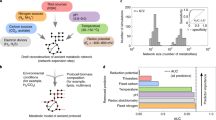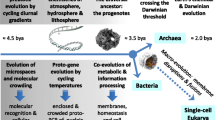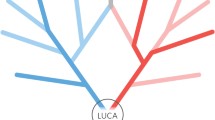Abstract
Reactions involving water and oxygen are basic features of geological and biological processes. To understand how life interacts with its environment requires monitoring interactions with \(\mathrm{H}_{2}\mathrm{O}\) and \(\mathrm{O}_{2}\) not only at timescales relevant to organismal growth but also over billions of years of geobiological evolution. Chemical transformations intrinsic to evolution and development were characterized by analyzing data from recent phylostratigraphic and proteomic studies. This two-stage analysis involves obtaining chemical metrics (carbon oxidation state and stoichiometric hydration state) from the elemental compositions of proteins followed by modeling the relative stabilities of target proteins against a proteomic background to infer thermodynamic parameters [oxygen fugacity, water activity, and virtual redox potential (Eh)]. The main results of this study are a rise in carbon oxidation state of proteins spanning the time of the Great Oxidation Event, a rise in virtual redox potential that coincides with the likely emergence of aerobic metabolism, and a rise in carbon oxidation state of proteins inferred from the transcriptome in late stages of Bacillus subtilis biofilm growth. Furthermore, stoichiometric hydration state of expressed proteins decreases through stages of biofilm development, drops at the same time as a drop in organismal water content during fruit fly development, and is lower for proteins with more recent gene ages, all of which support the inference of higher hydration potentials at earlier time points. These results show how the evolutionary and developmental dynamics of major chemical variables can be deciphered through thermodynamic analysis of proteins as chemical entities.








Similar content being viewed by others
Data Availability
Data were obtained from the UniProt database (The UniProt Consortium 2019) and the supporting files of previous studies (Liebeskind et al. 2016b; Casas-Vila et al. 2017; Trigos et al. 2017; Fabre et al. 2019; Futo et al. 2021; James et al. 2021) as described in the Materials and Methods and figure captions. Files with phylostrata assignments and UniProt IDs are available in the R package canprot version 1.1.2 (Dick 2021). Processed data files used in this study are in the “extdata/evdevH2O” directory of the JMDplots package (version 1.2.12 deposited on Zenodo with accession number 6137783) (Dick 2022), except for the differential expression dataset of Fabre et al. (2019), which is located under “extdata/expression/development.”
References
Albrecht SC, Barata AG, Grosshans J, Teleman AA, Dick TP (2011) In vivo mapping of hydrogen peroxide and oxidized glutathione reveals chemical and regional specificity of redox homeostasis. Cell Metab 14(6):819–829. https://doi.org/10.1016/j.cmet.2011.10.010
Anderson GM (2005) Thermodynamics of natural systems, 2nd edn. Cambridge University Press, Cambridge
Anderson GM, Crerar DA (1993) Thermodynamics in geochemistry: the equilibrium model. Oxford University Press, New York
Bagatolli LA, Stock RP (2021) Lipids, membranes, colloids and cells: a long view. Biochim Biophys Acta Biomembr 10:183684. https://doi.org/10.1016/j.bbamem.2021.183684
Bard JP (1986) Microtextures of igneous and metamorphic rocks. D. Reidel, Dordrecht
Brocchieri L, Karlin S (2005) Protein length in eukaryotic and prokaryotic proteomes. Nucleic Acids Res 33(10):3390–3400. https://doi.org/10.1093/nar/gki615
Calcagno PL, Hollerman CE, Jose PA (1972) Total body water: man. In: Altman PL, Dittmer DS (eds) Biology data book, vol 3, 2nd edn. Federation of American Societies for Experimental Biology, Bethesda, pp 1986–1989
Canty A, Ripley BD (2021) boot: bootstrap R (S-Plus) functions. R package version 1.3-28
Capra JA, Stolzer M, Durand D, Pollard KS (2013) How old is my gene? Trends Genet 29(11):659–668. https://doi.org/10.1016/j.tig.2013.07.001
Casas-Vila N, Bluhm A, Sayols S, Dinges N, Dejung M, Altenhein T, Kappei D, Altenhein B, Roignant JY, Butter F (2017) The developmental proteome of Drosophila melanogaster. Genome Res 27(7):1273–1285. https://doi.org/10.1101/gr.213694.116
Catling DC, Claire MW (2005) How Earth’s atmosphere evolved to an oxic state: a status report. Earth Planet Sci Lett 237(1):1–20. https://doi.org/10.1016/j.epsl.2005.06.013
Church RB, Robertson FW (1966) A biochemical study of the growth of Drosophila melanogaster. J Exp Zool 162(3):337–351. https://doi.org/10.1002/jez.1401620309
Cramer W (1916) On the biochemical mechanism of growth. J Physiol 50(5):322–334. https://doi.org/10.1113/jphysiol.1916.sp001758
Davison AC, Hinkley DV (1997) Bootstrap methods and their application. Cambridge University Press, Cambridge
Denbigh K (1981) The principles of chemical equilibrium, 4th edn. Cambridge University Press, Cambridge
Dick JM (2014) Average oxidation state of carbon in proteins. J R Soc Interface 11:20131095. https://doi.org/10.1098/rsif.2013.1095
Dick JM (2017) Chemical composition and the potential for proteomic transformation in cancer, hypoxia, and hyperosmotic stress. PeerJ 5:e3421. https://doi.org/10.7717/peerj.3421
Dick JM (2019) CHNOSZ: thermodynamic calculations and diagrams for geochemistry. Front Earth Sci 7:180. https://doi.org/10.3389/feart.2019.00180
Dick JM (2021) Water as a reactant in the differential expression of proteins in cancer. Comput Syst Oncol 1(1):e1007. https://doi.org/10.1002/cso2.1007
Dick JM (2022) JMDplots 1.2.12. Zenodo, https://doi.org/10.5281/zenodo.6137783
Dick JM, LaRowe DE, Helgeson HC (2006) Temperature, pressure, and electrochemical constraints on protein speciation: group additivity calculation of the standard molal thermodynamic properties of ionized unfolded proteins. Biogeosciences 3(3):311–336. https://doi.org/10.5194/bg-3-311-2006
Dick JM, Yu M, Tan J (2020) Uncovering chemical signatures of salinity gradients through compositional analysis of protein sequences. Biogeosciences 17(23):6145–6162. https://doi.org/10.5194/bg-17-6145-2020
Domazet-Lošo T, Carvunis AR, Albà MM, Šestak MS, Bakarić R, Neme R, Tautz D (2017) No evidence for phylostratigraphic bias impacting inferences on patterns of gene emergence and evolution. Mol Biol Evol 34(4):843–856. https://doi.org/10.1093/molbev/msw284
Downing JE, Christopherson WM, Broghamer WL (1962) Nuclear water content during carcinogenesis. Cancer 15(6):1176–1180
El-Gebali S, Mistry J, Bateman A, Eddy SR, Luciani A, Potter SC, Qureshi M, Richardson LJ, Salazar GA, Smart A, Sonnhammer ELL, Hirsh L, Paladin L, Piovesan D, Tosatto SCE, Finn RD (2019) The Pfam protein families database in 2019. Nucleic Acids Res 47(D1):D427–D432. https://doi.org/10.1093/nar/gky995
Evans KA, Powell R, Frost BR (2013) Using equilibrium thermodynamics in the study of metasomatic alteration, with an application to serpentinites. Lithos 168–169:67–84. https://doi.org/10.1016/j.lithos.2013.01.016
Fabre B, Korona D, Lees JG, Lazar I, Livneh I, Brunet M, Orengo CA, Russell S, Lilley KS (2019) Comparison of Drosophila melanogaster embryo and adult proteome by SWATH-MS reveals differential regulation of protein synthesis, degradation machinery, and metabolism modules. J Proteome Res 18(6):2525–2534. https://doi.org/10.1021/acs.jproteome.9b00076
Foley SF (2011) A reappraisal of redox melting in the Earth’s mantle as a function of tectonic setting and time. J Petrol 52(7–8):1363–1391. https://doi.org/10.1093/petrology/egq061
Frenkel-Pinter M, Rajaei V, Glass JB, Hud NV, Williams LD (2021) Water and life: the medium is the message. J Mol Evol 89(1):2–11. https://doi.org/10.1007/s00239-020-09978-6
Friis-Hansen B (1983) Water distribution in the foetus and newborn infant. Acta Paediatr 72(s305):7–11. https://doi.org/10.1111/j.1651-2227.1983.tb09852.x
Frost BR (1991) Introduction to oxygen fugacity and its petrologic importance. Oxide minerals, Reviews in mineralogy, vol 25. De Gruyter, Berlin, pp 1–10
Futo M, Opašić L, Koska S, Čorak N, Široki T, Ravikumar V, Thorsell A, Lenuzzi M, Kifer D, Domazet-Lošo M, Vlahoviček K, Mijakovic I, Domazet-Lošo T (2021) Embryo-like features in developing Bacillus subtilis biofilms. Mol Biol Evol 38(1):31–47. https://doi.org/10.1093/molbev/msaa217
Garrels RM, Christ CL (1965) Solutions, minerals, and equilibria. Harper & Row, New York
Gervais P, Molin P, Grajek W, Bensoussan M (1988) Influence of the water activity of a solid substrate on the growth rate and sporogenesis of filamentous fungi. Biotechnol Bioeng 31(5):457–463. https://doi.org/10.1002/bit.260310510
Gibbs JW (1876) On the equilibrium of heterogeneous substances. Trans Conn Acad Arts Sci 3:108–248
Haar L, Gallagher JS, Kell GS (1984) NBS/NRC steam tables: thermodynamic and transport properties and computer programs for vapor and liquid states of water in SI units. Hemisphere Publishing Corporation, Washington DC
Hartmann R, Jeckel H, Jelli E, Singh PK, Vaidya S, Bayer M, Rode DKH, Vidakovic L, Díaz-Pascual F, Fong JCN, Dragoš A, Lamprecht O, Thöming JG, Netter N, Häussler S, Nadell CD, Sourjik V, Kovács ÁT, Yildiz FH, Drescher K (2021) Quantitative image analysis of microbial communities with BiofilmQ. Nat Microbiol 6(2):151–156. https://doi.org/10.1038/s41564-020-00817-4
Heames B, Schmitz J, Bornberg-Bauer E (2020) A continuum of evolving de novo genes drives protein-coding novelty in Drosophila. J Mol Evol 88(4):382–398. https://doi.org/10.1007/s00239-020-09939-z
Hedges SB, Dudley J, Kumar S (2006) TimeTree: a public knowledge-base of divergence times among organisms. Bioinformatics 22(23):2971–2972. https://doi.org/10.1093/bioinformatics/btl505
Helgeson HC (1968) Evaluation of irreversible reactions in geochemical processes involving minerals and aqueous solutions. I. Thermodynamic relations. Geochim Cosmochim Acta 32(8):853–877. https://doi.org/10.1016/0016-7037(68)90100-2
Huang H, McGarvey PB, Suzek BE, Mazumder R, Zhang J, Chen Y, Wu CH (2011) A comprehensive protein-centric ID mapping service for molecular data integration. Bioinformatics 27(8):1190–1191. https://doi.org/10.1093/bioinformatics/btr101
James J, Willis S, Nelson P, Weibel C, Kosinski L, Masel J (2020) Data from: Universal and taxon-specific trends in protein sequences as a function of age. Figshare. https://doi.org/10.6084/m9.figshare.12037281.v1
James JE, Willis SM, Nelson PG, Weibel C, Kosinski LJ, Masel J (2021) Universal and taxon-specific trends in protein sequences as a function of age. eLife 10:e57347. https://doi.org/10.7554/eLife.57347
Jones DP, Sies H (2015) The redox code. Antioxid Redox Signal 23(9):734–746. https://doi.org/10.1089/ars.2015.6247
Kasting JF (1993) Earth’s early atmosphere. Science 259(5097):920–926. https://doi.org/10.1126/science.11536547
Kinniburgh DG, Cooper DM (2004) Predominance and mineral stability diagrams revisited. Environ Sci Technol 38(13):3641–3648. https://doi.org/10.1021/es034927l
Kitadai N (2014) Thermodynamic prediction of glycine polymerization as a function of temperature and pH consistent with experimentally obtained results. J Mol Evol 78(3–4):171–187. https://doi.org/10.1007/s00239-014-9616-1
Kumar S, Stecher G, Suleski M, Hedges SB (2017) TimeTree: a resource for timelines, timetrees, and divergence times. Mol Biol Evol 34(7):1812–1819. https://doi.org/10.1093/molbev/msx116
Kump LR (2008) The rise of atmospheric oxygen. Nature 451(7176):277–278. https://doi.org/10.1038/nature06587
Lamadrid HM, Rimstidt JD, Schwarzenbach EM, Klein F, Ulrich S, Dolocan A, Bodnar RJ (2017) Effect of water activity on rates of serpentinization of olivine. Nat Commun 8(1):16107. https://doi.org/10.1038/ncomms16107
LaRowe DE, Dick JM (2012) Calculation of the standard molal thermodynamic properties of crystalline peptides. Geochim Cosmochim Acta 80:70–91. https://doi.org/10.1016/j.gca.2011.11.041
Liebeskind B, McWhite CD, Hines K (2016a) Gene-Ages v1.0. Zenodo. https://doi.org/10.5281/zenodo.51708
Liebeskind BJ, McWhite CD, Marcotte EM (2016) Towards consensus gene ages. Genome Biol Evol 8(6):1812–1823. https://doi.org/10.1093/gbe/evw113
Lipman DJ, Souvorov A, Koonin EV, Panchenko AR, Tatusova TA (2002) The relationship of protein conservation and sequence length. BMC Evol Biol 2(1):20. https://doi.org/10.1186/1471-2148-2-20
Logan JE, Himwich WA (1972) Animal tissues and organs: water content. In: Altman PL, Dittmer DS (eds) Biology data book, vol 1, 2nd edn. Federation of American Societies for Experimental Biology, Bethesda, pp 392–398
Lyons TW, Reinhard CT, Planavsky NJ (2014) The rise of oxygen in Earth’s early ocean and atmosphere. Nature 506(7488):307–315. https://doi.org/10.1038/nature13068
Martin WF, Sousa FL (2016) Early microbial evolution: the age of anaerobes. Cold Spring Harbor Perspect Biol 8(2):a018127. https://doi.org/10.1101/cshperspect.a018127
McIntyre GI (2006) Cell hydration as the primary factor in carcinogenesis: a unifying concept. Med Hypotheses 66(3):518–526. https://doi.org/10.1016/j.mehy.2005.09.022
Moyers BA, Zhang J (2017) Further simulations and analyses demonstrate open problems of phylostratigraphy. Genome Biol Evol 9(6):1519–1527. https://doi.org/10.1093/gbe/evx109
do Nascimento Vieira A, Kleinermanns K, Martin WF, Preiner M (2020) The ambivalent role of water at the origins of life. FEBS Lett 594(17):2717–2733. https://doi.org/10.1002/1873-3468.13815
Natsidis P, Kapli P, Schiffer PH, Telford MJ (2021) Systematic errors in orthology inference and their effects on evolutionary analyses. Science 24(2):102110. https://doi.org/10.1016/j.isci.2021.102110
Okegbe C, Price-Whelan A, Dietrich LEP (2014) Redox-driven regulation of microbial community morphogenesis. Curr Opin Microbiol 18:39–45. https://doi.org/10.1016/j.mib.2014.01.006
Olmstead EG (1966) Mammalian cell water. Lea & Febiger, Philadelphia
Pace NR (1991) Origin of life: facing up to the physical setting. Cell 65(4):531–533. https://doi.org/10.1016/0092-8674(91)90082-A
R Core Team (2021) R: a language and environment for statistical computing. R Foundation for Statistical Computing, Vienna, Austria. https://www.R-project.org
Ross KFA, Gordon RE (1982) Water in malignant tissue, measured by cell refractometry and nuclear magnetic resonance. J Microsc 128(1):7–21. https://doi.org/10.1111/j.1365-2818.1982.tb00433.x
Rumble D III (1982) The role of perfectly mobile components in metamorphism. Annu Rev Earth Planet Sci 10(1):221–233. https://doi.org/10.1146/annurev.ea.10.050182.001253
Saryan LA, Hollis DP, Economou JS, Eggleston JC (1974) Nuclear magnetic resonance studies of cancer. IV. Correlation of water content with tissue relaxation times. J Natl Cancer Inst 52(2):599–602. https://doi.org/10.1093/jnci/52.2.599
Schwarzländer M, Dick TP, Meyer AJ, Morgan B (2016) Dissecting redox biology using fluorescent protein sensors. Antioxid Redox Signal 24(13):680–712. https://doi.org/10.1089/ars.2015.6266
Smith E, Morowitz HJ (2016) The origin and nature of life on Earth. Cambridge University Press, Cambridge
Solel E, Tarannam N, Kozuch S (2019) Catalysis: energy is the measure of all things. Chem Commun 55:5306–5322. https://doi.org/10.1039/C9CC00754G
Stevenson A, Cray JA, Williams JP, Santos R, Sahay R, Neuenkirchen N, McClure CD, Grant IR, Houghton JD, Quinn JP, Timson DJ, Patil SV, Singhal RS, Anton J, Dijksterhuis J, Hocking AD, Lievens B, Rangel DEN, Voytek MA, Gunde-Cimerman N, Oren A, Timmis KN, McGenity TJ, Hallsworth JE (2015) Is there a common water-activity limit for the three domains of life? ISME J 9(6):1333–1351. https://doi.org/10.1038/ismej.2014.219
Tcherkas YV, Denisenko AD (2001) Simultaneous determination of several amino acids, including homocysteine, cysteine and glutamic acid, in human plasma by isocratic reversed-phase high-performance liquid chromatography with fluorimetric detection. J Chromatogr A 913(1–2):309–313. https://doi.org/10.1016/S0021-9673(00)01201-2
The UniProt Consortium (2019) UniProt: a worldwide hub of protein knowledge. Nucleic Acids Res 47(D1):D506–D515. https://doi.org/10.1093/nar/gky1049
Trigos AS, Pearson RB, Papenfuss AT, Goode DL (2017) Altered interactions between unicellular and multicellular genes drive hallmarks of transformation in a diverse range of solid tumors. Proc Natl Acad Sci 114(24):6406–6411. https://doi.org/10.1073/pnas.1617743114
Van Oss SB, Carvunis AR (2019) De novo gene birth. PLoS Genet 15(5):e1008160. https://doi.org/10.1371/journal.pgen.1008160
Wagman DD, Evans WH, Parker VB, Schumm RH, Halow I, Bailey SM, Churney KL, Nuttall RL (1982) The NBS tables of chemical thermodynamic properties. Selected values for inorganic and \({{\rm C}}_{1}\) and \({{\rm C}}_{2}\) organic substances in SI units. J Phys Chem Ref Data 11(Suppl. 2):1–392. https://srd.nist.gov/JPCRD/jpcrdS2Vol11.pdf
Wedberg R, Abildskov J, Peters GH (2012) Protein dynamics in organic media at varying water activity studied by molecular dynamics simulation. J Phys Chem B 116(8):2575–2585. https://doi.org/10.1021/jp211054u
Weiss MC, Sousa FL, Mrnjavac N, Neukirchen S, Roettger M, Nelson-Sathi S, Martin WF (2016) The physiology and habitat of the last universal common ancestor. Nat Microbiol 1:16116. https://doi.org/10.1038/nmicrobiol.2016.116
Williams RJP, Fraústo Da Silva JJR (2003) Evolution was chemically constrained. J Theor Biol 220(3):323–343. https://doi.org/10.1006/jtbi.2003.3152
Wilson BA, Foy SG, Neme R, Masel J (2017) Young genes are highly disordered as predicted by the preadaptation hypothesis of de novo gene birth. Nat Ecol Evol 1(6):0146. https://doi.org/10.1038/s41559-017-0146
Wimmer JLE, do Nascimento Vieira A, Xavier JC, Kleinermanns K, Martin WF, Preiner M, (2021) The autotrophic core: an ancient network of 404 reactions converts \({{\rm H}}_{2}\), \({{\rm CO}}_{2}\), and \({{\rm NH}}_{3}\) into amino acids, bases, and cofactors. Microorganisms 9(2):458. https://doi.org/10.3390/microorganisms9020458
Winzler RJ (1959) The chemistry of cancer tissue. In: Homburger F (ed) The physiopathology of cancer, 2nd edn. Hoeber-Harper, New York, pp 686–706
Zhou JX, Cisneros L, Knijnenburg T, Trachana K, Davies P, Huang S (2018) Phylostratigraphic analysis of tumor and developmental transcriptomes reveals relationship between oncogenesis, phylogenesis and ontogenesis. Converg Sci Phys Oncol 4(2):025002. https://doi.org/10.1088/2057-1739/aab1b0
Funding
No funding was received for this work.
Author information
Authors and Affiliations
Corresponding author
Ethics declarations
Conflict of interest
The author declares no competing interests.
Code Availability
The code used to make the figures for this paper is available in the JMDplots package (Dick 2022). The maximum activity analysis described here has been implemented in a new function named MaximAct(). The “evdevH2O.Rmd” vignette in the package runs the functions to make each of the figures and has code blocks to generate particular values mentioned in the text.
Additional information
Handling editor: Ashley Teufel.
Rights and permissions
About this article
Cite this article
Dick, J.M. A Thermodynamic Model for Water Activity and Redox Potential in Evolution and Development. J Mol Evol 90, 182–199 (2022). https://doi.org/10.1007/s00239-022-10051-7
Received:
Accepted:
Published:
Issue Date:
DOI: https://doi.org/10.1007/s00239-022-10051-7




